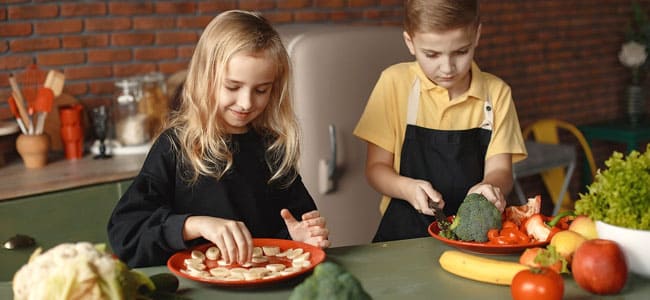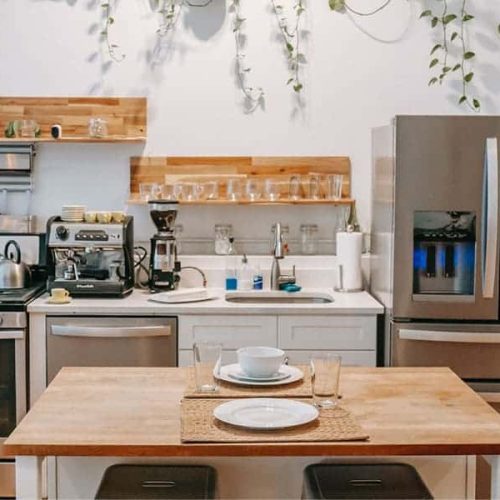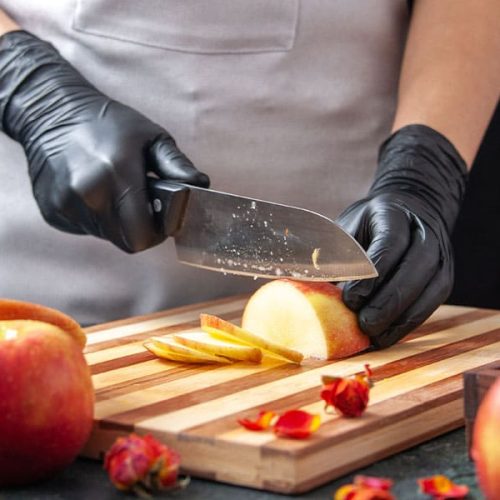Table of Contents
- Introduction
- Kitchen Dress
- Organize Kitchen Space
- Fire Safety Measures
- Knife Handling Techniques
- Handling Hot Surfaces and Liquids
- Electrical Safety Precautions
- Preventing Cross-Contamination
- Child Safety in the Kitchen
- Handling kitchen Accidents
- Routine Maintenance Plan
- Summary
- Frequently Asked Questions
Introduction
Cooking at home means safety should be a top priority. A well-organized and safe kitchen not only ensures physical well-being but also contributes to an efficient and enjoyable cooking experience. Proper safety measures, minimizes the risk of accidents and creates a secure environment for culinary creativity. This article will explain essential tips for safe kitchen work at home and how to master kitchen safety.
Kitchen Dress
As applicable for other activities of daily life, kitchen work also requires a certain dress for safety and efficient work. In this regard following is suggested:
- Synthetic fibers such as rayon and polyester are unsafe to wear while cooking. The best and safest option is to wear cotton cloth in such conditions.
- Long sleeves can potentially cause difficulties and increase the risk of accidents.
- Wearing a headgear will prevent the dropping of loose hairs into the food.
- An apron is essential for protecting your clothes.
- Slip-on or clog-style shoes are convenient for easy wearing and removal.
Organize Kitchen Space
An organized workspace is vital for safety in the home kitchen. A clean and orderly environment, minimizes the risk of accidents and enhances efficiency in cooking.
- Remove unnecessary items from countertop to provide ample space for food preparation.
- Arrange kitchen equipment and utensils thoughtfully to ensure easy access and minimize the chance of them falling or causing accidents.
- Designated storage areas for hazardous substances, such as cleaning agents and sharp objects, should be established. This prevents accidental ingestion or mishandling, especially if there are children in the house.
- Place heavier appliances in lower cabinets or shelves.
- Use a small stepladder to reach higher shelves.
- Clean up spills on floors and counters quickly.

Image is curtesy of pexels.com
Fire Safety Measures
Fire safety is important in the kitchen, as the combination of heat, flammable materials, and electrical appliances can pose risks. Necessary precautions, can minimize the likelihood of fire-related accidents.
- Install smoke detectors and fire extinguishers in kitchen. Place smoke detectors strategically to ensure early detection of any potential fire hazards, and keep a fire extinguisher within reach for quick response.
- Safe usage of Electrical appliances largely depends on maintenance and following the manufacturer’s instructions, inspecting cords for damage, and promptly addressing any issues.
- Grease fires can quickly escalate. To prevent them, avoid overheating of oil and always stay vigilant when cooking with fats or oils. If a grease fire does occur, never use water to extinguish it. Instead, carefully place a lid on the pan to smother the flames or use a fire extinguisher specifically designed for grease fires.
Knife Handling Techniques
Knife is an essential tool in every kitchen, but improper handling can result in severe injuries. Mastering proper knife handling techniques ensures your safety while performing various cooking tasks.
- Make sure your cutting board is secure and doesn’t slip while you’re using it.
- Choose knife according to your work or type of cutting required
- Keep your fingers and thumbs away from the blade.
- Never cut toward yourself.
- Don’t wave your knives in the air.
- Keep your knives clean and sharp.
- When gripping a knife, ensure a firm but comfortable hold. Avoid gripping too tightly, as it can compromise your control and lead to accidents.
- Always concentrate on the task at hand and refrain from distractions to minimize the risk of injury.
Handling Hot Surfaces and Liquids
Hot surfaces and liquids pose a significant risk of burns and scalds. By adopting safe practices, you can protect yourself from these potential hazards.
- Do not allow oil temperature very high or visibly when it starts giving smoke.
- When oil temperature is high place a lid on it after putting food in the pan.
- Handle boiling water with care.
- Make use of Gloves for handling food in micro wave or baking oven.
- Never leave your stove unattended while cooking.
- Create a kid-free zone.
- Keep your cooking area free of flammable materials.
- Turn pot handles toward the back of the stove.
- Keep a fire extinguisher nearby.
- Keep cooking equipment clean.
Electrical Safety Precautions
Electricity is essential in the kitchen, but improper handling can lead to dangerous situations. Implementation of electrical safety precautions, can minimize the risk of electrical accidents.
- Make Regular inspection of wires and outlets for potential hazards like frayed cords or exposed wiring and immediate repair or replacement of faulty components.
- Proper grounding of electrical appliances will prevent shocks or electrical fires. Utilize surge protectors and avoid using damaged cords or outlets.
Preventing Cross-Contamination
Cross-contamination is a significant concern in the kitchen, potentially leading to foodborne illness. By understanding the dangers and implementing preventive measures, you can maintain a safe and hygienic cooking environment.
- Cross-contamination occurs when bacteria or pathogens from one food item transfer to another. To prevent this, store raw and cooked foods separately, using proper containers and wrapping.
- For proper storage and handling of raw and cooked foods, strictly adhere to recommended temperatures for storage and avoid extended exposure to perishable foods at room temperature.
- Effective cleaning and sanitization, including use of separate cutting boards for different foods, regular hand wash and surface cleaning, prevents the spread of bacteria and reduces the risk of cross-contamination.
- Always wash fruits, vegetables, and meats thoroughly before consumption or cooking.
- Use safe defrosting techniques, such as defrosting meat in the refrigerator or using a microwave on the defrost setting. Avoid leaving food at room temperature for defrosting, as it promotes bacterial growth.
- Food storage at appropriate temperature is crucial for preventing spoilage. Keep perishable foods refrigerated, at temperature below 40°F (4°C).
Child Safety in the Kitchen
Child safety measures is a must to do at home kitchen. Create a safe environment where they can observe and learn without exposing themselves to unnecessary risks.
- Establish clear boundaries to keep children away from potentially dangerous areas or appliances.
- Always supervise children when they are in the kitchen. Keep an eye on their actions and provide guidance to prevent accidents or mishaps.
- Teach children basic kitchen safety rules, such as avoiding hot surfaces, proper handling of knives, and the importance of hand wash.

Image is curtesy of pixabay.com
Handling kitchen Accidents
Despite precautions, accidents can still occur in the kitchen. Being prepared and having basic knowledge of first-aid procedures ensures a prompt and appropriate response.
- It’s important to have a well-stocked first-aid kit readily available in your kitchen. The kit should contain essentials such as bandages, antiseptic ointments, and sterile gauze.
- Learn basic first-aid procedures, including treating minor burns, cuts, and choking incidents. Knowing how to react swiftly in emergency situations can make a significant difference in the outcome.
- Recognize when professional medical help is necessary. If an injury or emergency exceeds your ability to provide aid, call emergency services or seek medical attention without delay.
Routine Maintenance Plan
Regular maintenance is essential for a safe and efficient home kitchen. Implementation of a routine maintenance plan will ensure smooth functioning.
- Regularly inspect kitchen appliances for any signs of fault or damage. Pay attention to issues such as faulty wiring, broken seals, or malfunctioning controls.
- Address faulty equipment promptly by repairing or replacing the affected parts. Leaving damaged equipment unattended can lead to accidents or further damage.
- Conduct preventive maintenance tasks, such as cleaning vents, checking gas connections, or lubricating moving parts. These measures contribute to a safe and well-maintained kitchen environment.
Summary
To learn the art of safety in home kitchen, use of essential safety measures is very important. Organized kitchen space, implementing fire safety measures, proper handling of knives and considering electrical safety, will create a secure cooking environment. Additionally, preventing cross-contamination, practicing safe food preparation and storage, ensuring child safety, and being prepared for emergencies contribute to a seamless and worry-free kitchen experience. Prioritizing safety not only protects you and your loved ones from accidents but also allows to fully enjoy the pleasures of cooking without exposure to unnecessary risks.
Frequently Asked Questions
- How often should I clean and sanitize my kitchen surfaces?
Ideally, kitchen surfaces should be cleaned and sanitized after every use. It’s essential to prevent the growth and spread of bacteria that can cause foodborne illnesses.
- What should I do if a grease fire occurs?
In case of a grease fire, immediately turn off the heat source. Never use water, as it can cause the grease to splatter and intensify the fire. Instead, smother the flames with a lid or use a fire extinguisher rated for grease fires.
- Can I safely use an electric appliance with a damaged cord?
No, it is not safe to use an electric appliance with a damaged cord. Damaged cords can pose an electrical hazard, increasing the risk of shocks or fires. Repair or replace the damaged cord before using the appliance.
- How can I ensure my kitchen remains childproof?
Establish boundaries and use childproof locks or safety gates to restrict access to potentially dangerous areas. Supervise children at all times during cooking activities and teach them basic kitchen safety rules to develop their awareness and understanding.
- Is it necessary to attend a first-aid course for kitchen emergencies?
While attending a first-aid course is not mandatory, it is highly recommended. A first-aid course equips you with essential skills and knowledge to handle emergencies confidently and effectively. It prepares you to respond appropriately in critical situations and could potentially save lives.





